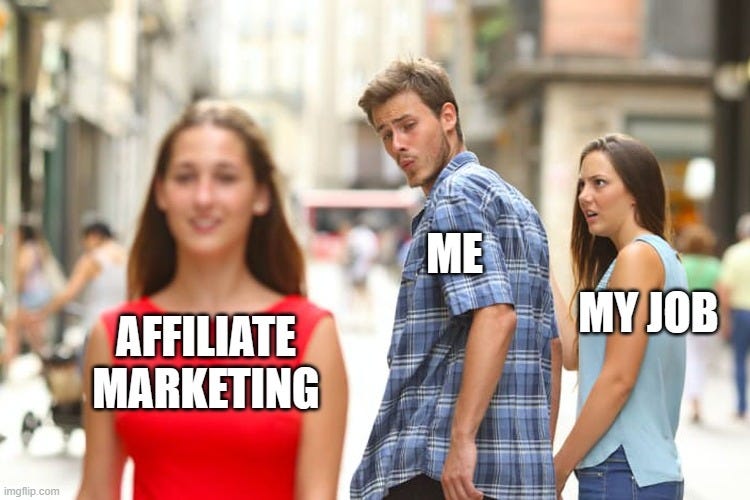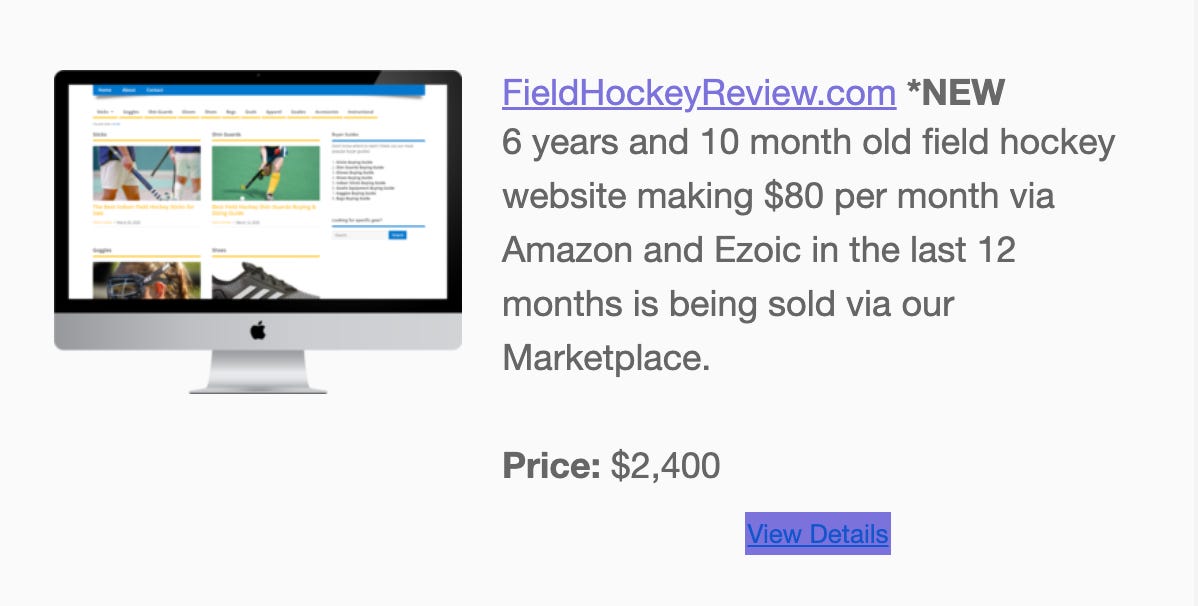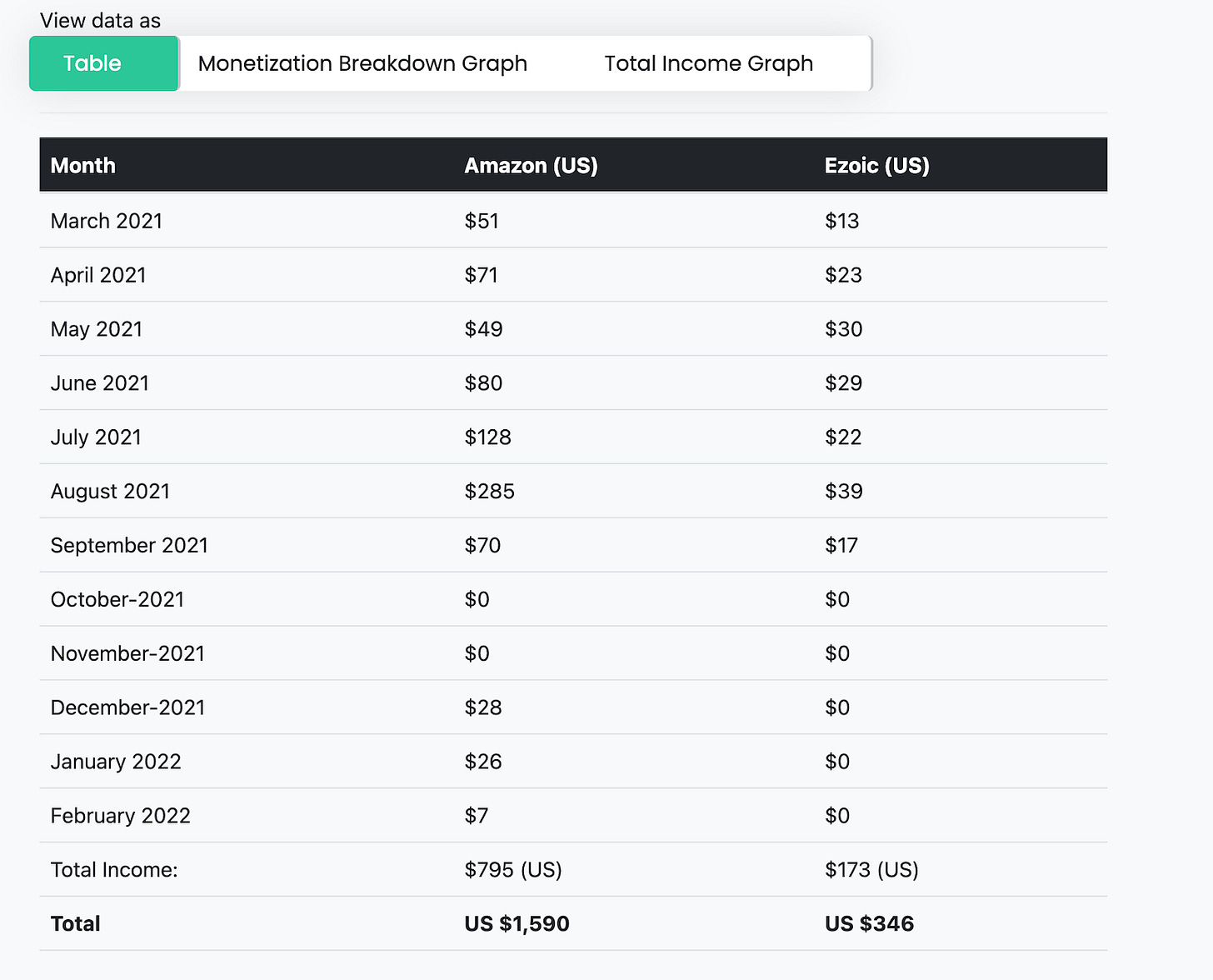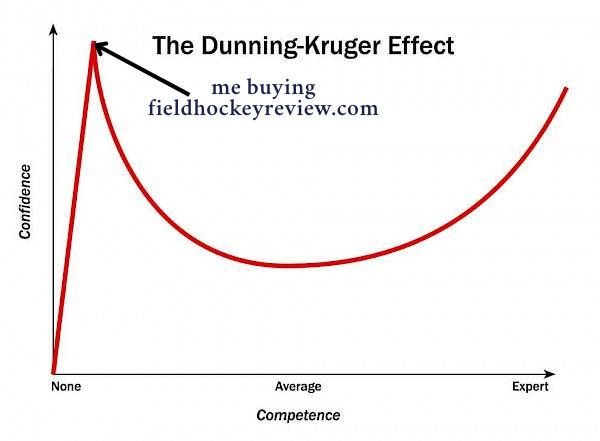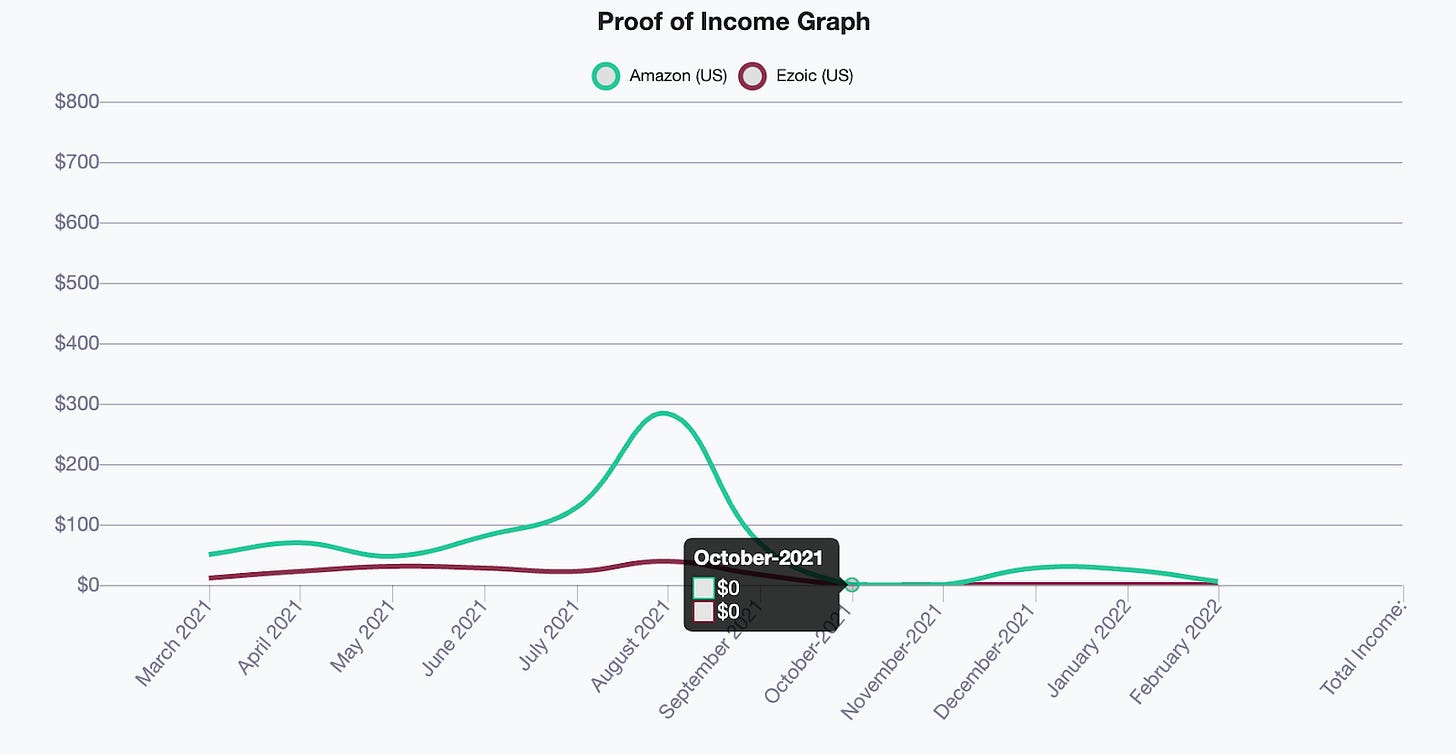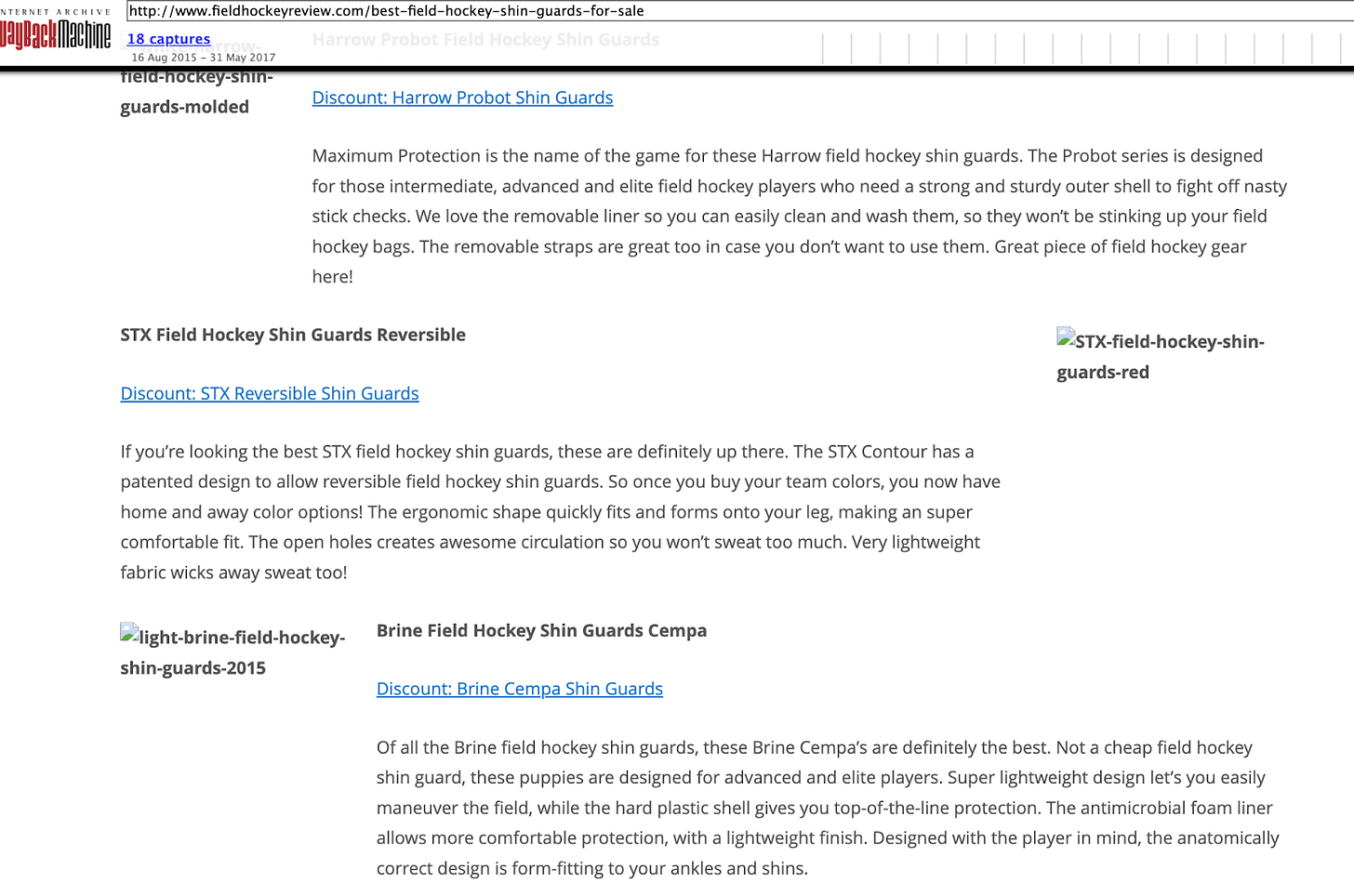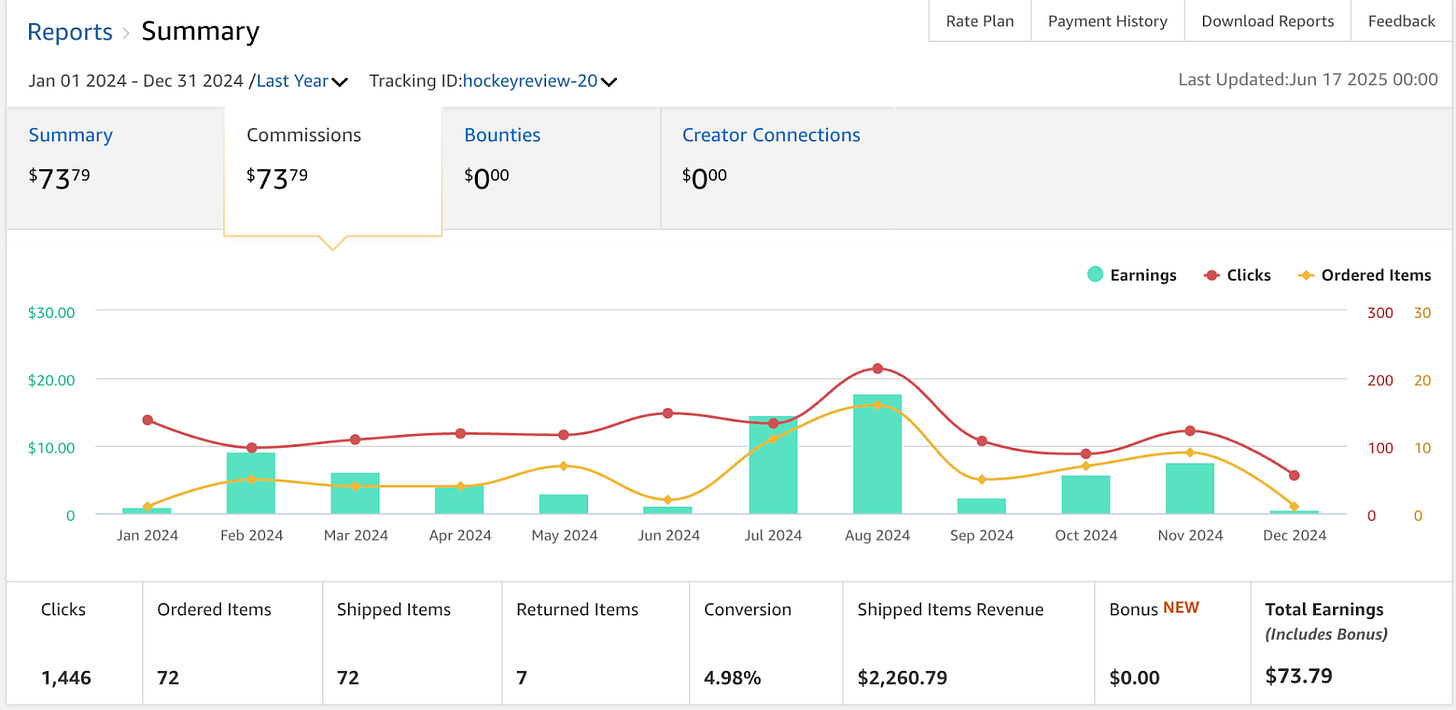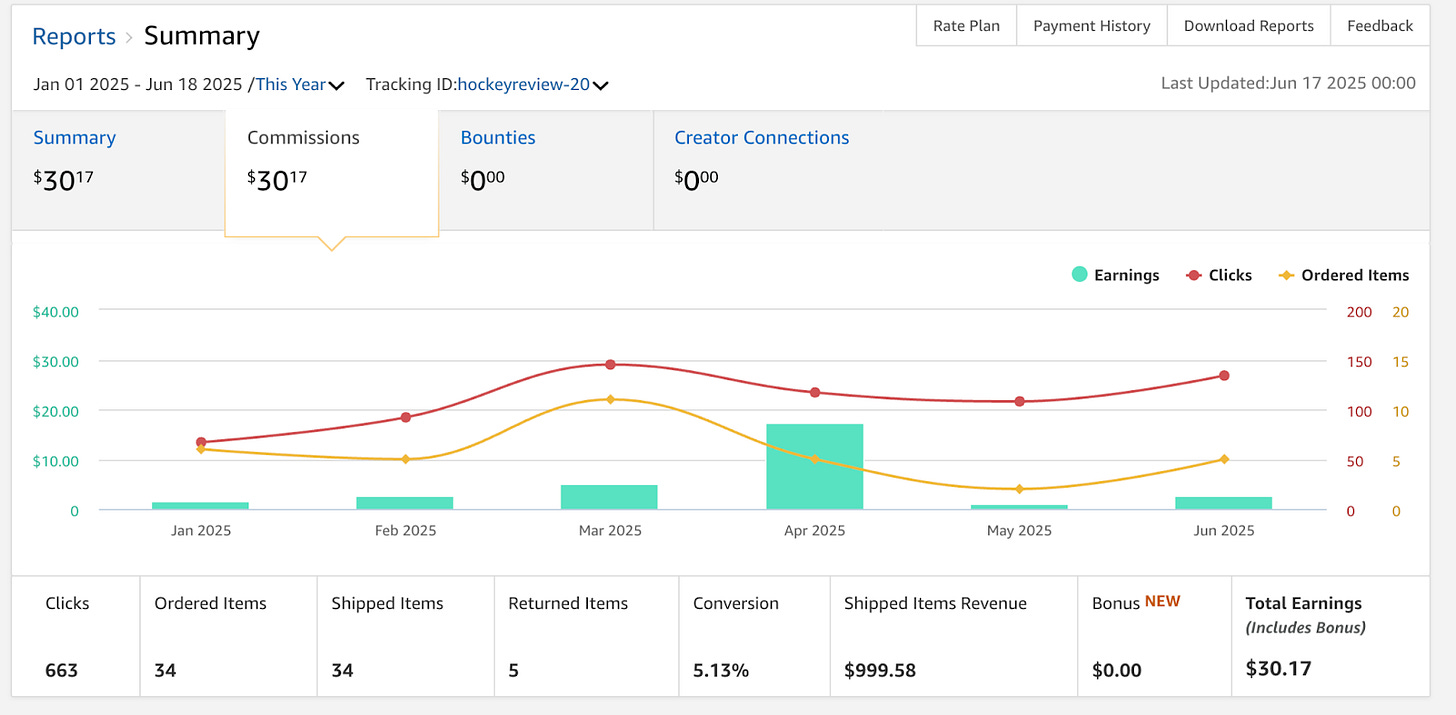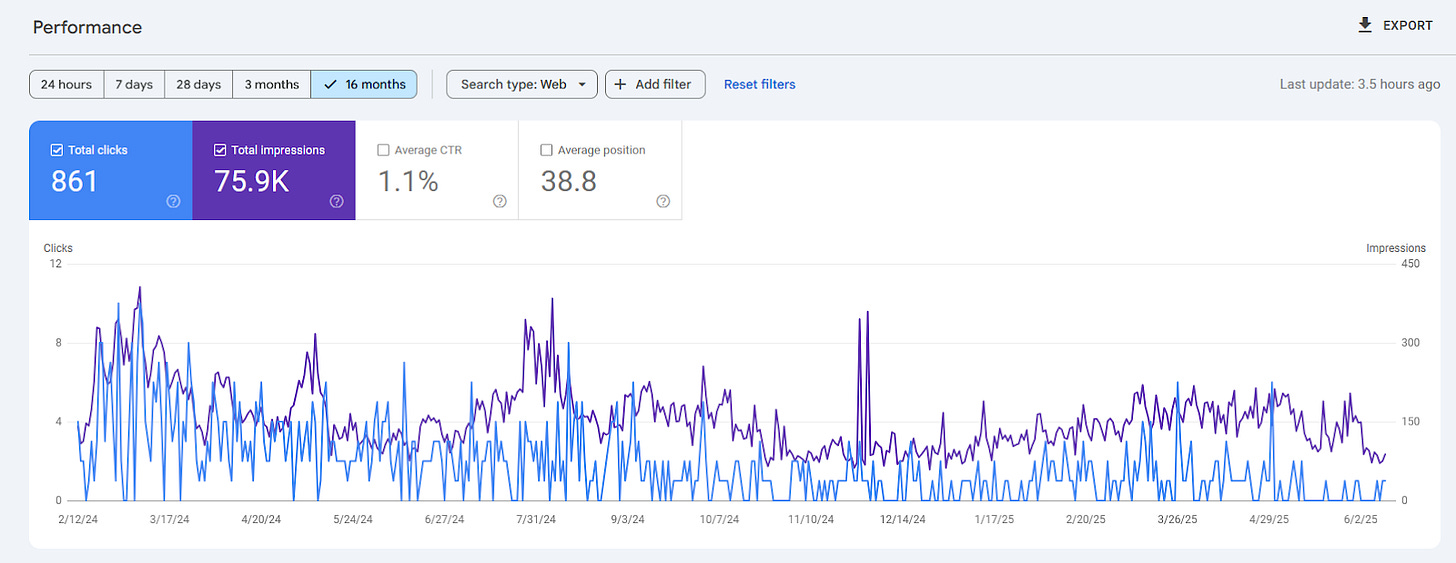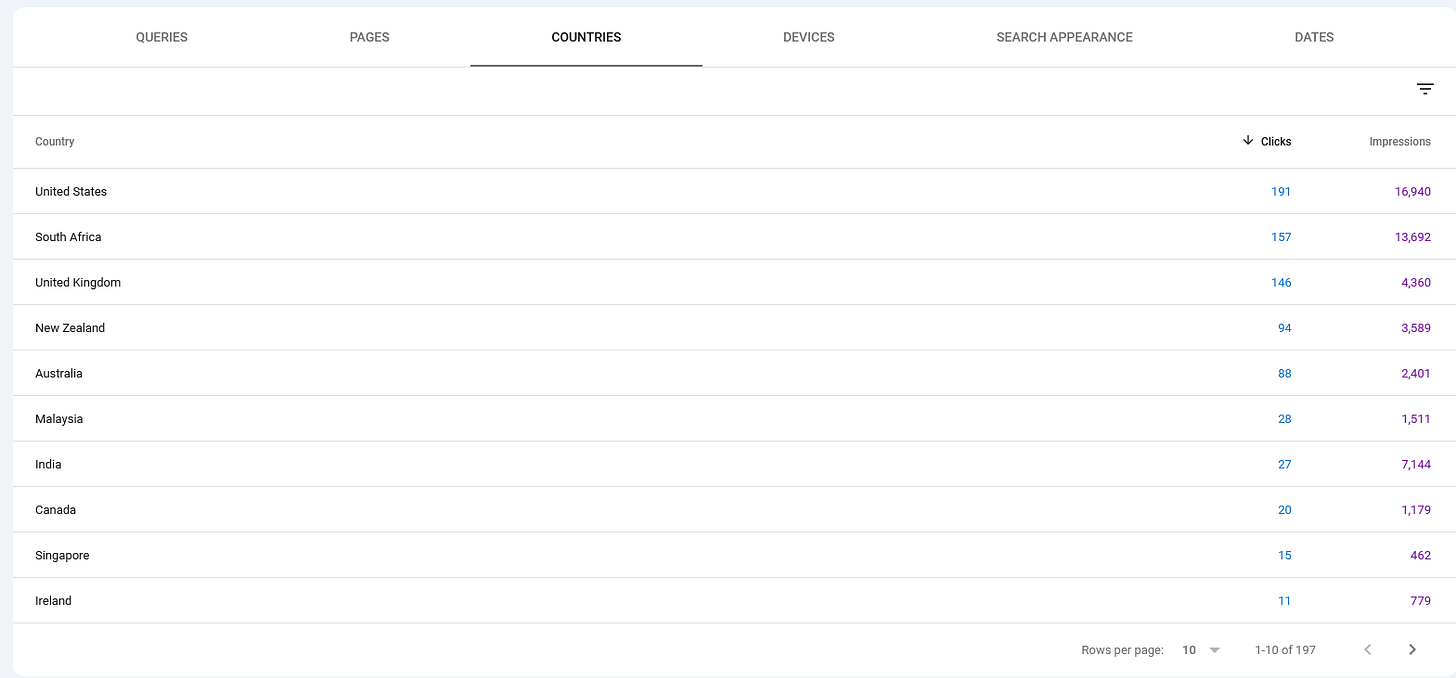I Bought a $2,400 Website and Made $546. Here’s What Went Wrong
Lessons from my attempt to revive an Amazon affiliate site in the field hockey niche.
Fresh out of university, I landed my first stable job—and with it, my first steady income. Like many others fascinated by online income streams, I became obsessed with niche content websites. At the time, I was following Spencer Haws and his project Niche Pursuits, where he taught how to build niche sites that generate income through affiliate marketing.
These websites mostly consisted of review-style articles targeting low-competition keywords—“Best Laptops for Nursing Students”, “Top Kitchen Blenders Under $100” — designed to attract readers with buying intent.
Not the most passionate thing to do, but if you choose a niche you like, and start seeing progress, this could become a solid business.
I was so hyped about the idea at the time, that I started building websites myself , targeting random low-competition keywords.
One was on Vue.js—even though I didn’t know the framework at all. It still managed to get a few thousand monthly users, and some pocket money from Google Adsense.
Other experiments, like blogs about discharged batteries or cat food, flopped. I lost interest quickly, especially after realizing I couldn’t write 50+ articles on cat food without repeating myself.
After a few failed experiments, I felt ready to try something riskier: buying an existing site instead of starting from scratch.
In this post, I’ll walk you through the real numbers, what went wrong, and the key lessons I’d apply next time—so you can avoid burning your own $2,400.
Finding “The One”
I use quotes intentionally—because, spoiler alert: it wasn’t the best choice.
My goal was to find a site that:
Was affordable (didn’t cost tens of thousands of euros)
Wasn’t spammy or built with black-hat SEO
Had solid content that delivered real value - not SEO content stuffed with keywords
There are a few places to look for websites for sale. The biggest is Flippa.com. However, I ended up on MotionInvest.com, a marketplace launched by the same Spencer Haws I’d been following.
One listing caught my attention: a field hockey review site.
Here’s the original listing I found in my inbox from March 11, 2022.
It looked like a great deal: aged domain, content that ranked well on Google, and steady monthly income.
The sport is seasonal - biggest spikes in August–September, especially in the US—but the income graph still seemed solid.
An operational website, generating revenue for years. A little bit outdated, but that’s where the potential is, right?
I was confident. Faster server, better design, polished content, new posts. I’d triple the revenue in no time.
Looking back, I was at the peak of Mt. Stupid. Some experience gave me the false impression that I could do it better. “After all, I’m a technical person. I’ll get quick wins and make it betterl.”
But… there was this one detail.
The Crucial 2 Months That Defined the Website
Two months where the income dropped to zero..
Coincidence? Not really. Even for seasonal sites, a total income blackout is rare. Maybe lower traffic, but not zero.
The reason for this was disclosed in the listing:
The site was down for 2 months.
That’s a lot of time for SEO rankings to start tanking.
But the price reflected that. Motion Invest generally calculates pricing as 30x the average monthly income over 6 months.
So it made sense to me. I figured I’d revive it—migrate to my server, update the theme, add new content—and watch it bounce back.
Looking back, I underestimated how much two months of downtime damages SEO. I should’ve seen it as a red flag, not a discount opportunity.
The Buying Process
Believing this was a good deal, I decided to move forward. The money was on the table, and the process was new—and stressful.
The first part of the payment was a $1,000 deposit. That was simple enough—probably done through PayPal (don’t remember exactly).
But the remaining $1,389 had to be sent via wire transfer to a Canadian bank. For someone used to SEPA payments, this felt unnecessarily complicated. I had to convert EUR to USD, input routing numbers, branch transit codes, and other unfamiliar fields.
PayPal was an option for the full payment—but the 5% fee meant paying over $100 just for convenience. That was too much for me.
So I went with the wire transfer, even though I wasn’t 100% comfortable. A few days later, confirmation came in.
The Transfer
The process was relatively smooth. Shortly after payiment, I got an email from the person responsible for the transfer. I was asked to provide “hosting login details”, which was pretty vague.
I had already spun up a fresh VPS (virtual private server) on Hostinger for the site—it’s my go-to for small projects. Their plans are affordable, and since the site targets the US market with Amazon affiliate links (that’s where the money is in the field hockey niche), having a US-based server helped deliver faster load times for American visitors.
I sent my server’s root credentials. They asked me to install WordPress and send the access details. At that point, I just asked them to give me the backup so I could do it myself.
They responded saying they’d need just 15–20 minutes if I gave them access.
Turns out, the site had been backed up via a plugin. But the restored version didn’t work with the latest PHP version on my server.
And just like that, I was debugging PHP compatibility issues, wondering if I’d bought a digital asset—or a second job. And it wasn’t 20 minutes from the transfer team after all.
Bringing It Back to Life
Here is how the site looked like in 2021.
Here’s what I found:
Broken Amazon links - many items were permanently out of stock. Some of them were linked incorrectly - instead of amazon.com, they lead to fieldhockeyreview.com/dp/1591642442 (seems to be an issue of one of the faulty plugins that was used)
Outdated Wordpress theme and plugins - it hadn’t been updated in years.
Too many plugins - plugins for everything—redirects, tables, SSL, etc.. Some of them were clashing with each other, some of them were broken and ruining the site.
One of the first things that had to be changed were the broken Amazon affiliate links. There were plenty of them, but majority of them were out of stock, or items no longer existed:
The images in affiliate articles were also broken due to an old, unmaintained plugin. There was a lot of manual work in reviewing articles and fixing links.
It does not look like much, but when the website has tens of articles, with dozens of links in each of them, everything takes time.
Could I have used a paid plugin to speed things up?
Sure. But I didn’t want to invest more money. Plus, I wanted to learn the niche, so I reviewed everything myself. And even using a paid plugin it would involve some manual work.
I also added a couple of new posts:
The Best Field Hockey Books
How to Clean Field Hockey Goalie Gear?
But content opportunities were limited. Most product categories were already covered in the website. Field hockey is a pretty small niche.
One key mistake I made was removing unavailable products. Turns out, Google didn’t like that. Rankings for some posts dropped.
I found some legacy items being formatted with strikethrough instead of completely being removed. Here is an example of that:
Seems that this is a better approach than deleting it from the post.
One thing I was fully aware of: making multiple changes at once is not ideal. It becomes hard to isolate which tweak caused which result. And if rankings drop, you’re left guessing what went wrong—and it becomes much harder to recover.
So I let the site sit for a while after the initial clean-up. I wanted to give Google time to re-index and (hopefully) reward the improvements.
When the rankings didn’t improve, I made a conscious decision to take a bigger risk: I updated the theme.
That’s always a gamble. A full redesign can sometimes upset Google, especially if the visual or structural changes are significant. But the site was already underperforming, so I figured there was nothing to lose.
Did all of the changes Help?
Not really.
I don’t have access to the original Google Analytics 3 data, but I can tell you that the site didn’t bounce back.
Compared to when the previous owner ran it, both rankings and income were down.
Those two months of downtime turned out to be fatal. And Google didn’t reward my cleanup work.
The Earnings
And now comes the most interesting part - how much I earned from the website?
Amazon affiliate income was the main revenue stream, with some extra from Ezoic ads.
I had another site on the same Amazon store tag, so it’s tricky to isolate numbers. But roughly:
2022: ~$232
2023: ~$189
2024: ~$73 (broken images hurt conversions)
2025 (so far): ~$30
Ezoic Ads: ~$52
Current Status
A few months ago, I took some time to update the site: fixed broken links, refreshed a few articles, removed underperforming ones, and added new posts featuring products that were actually in stock.
There was a slight bump in April's revenue, but overall, it didn’t have much of an impact.
Here’s what the traffic looks like today:
With majority of it being from United States:
And everything is a grand total of around 546$ in 3 years.
Was It Worth It?
Financially? No. I lost money.
But in terms of experience? Absolutely worth it.
I learned more from this one failed project than from all the YouTube videos, blog posts, and online forums combined. I now understand how to:Notice red flags and how much it might cost in the long term
Migrate and fix aging websites (this one I would say is a red flag, as a Wordpress with unmaintained tech stack is a pain to deal with and upgrade might break everything that still works)
Treat websites like an asset.
Would I buy another site? Maybe.
But if I had to do it again, I would:
Avoid sites with recent downtime or penalization risk.
Only buy in niches I understand (and care about).
Spend the first month observing traffic before making big changes.
Use paid tools or plugins if they save me 20+ hours.
Future of affiliate websites
With the AI being able to generate content in no time, affiliate websites future is unclear. It's easier than ever to spin one and stuff it with affiliate links. However the maintenance of it is another case.
It's even harder to predict if the smaller ones, like Fieldhockeyreview.com in my case, will survive.
There are well established affiliate websites with great rankings, and the whole team dedicated, so such businesses will keep existing. But even for them, the habits that might potentially change with the people using AI for search more, is a challenge.


